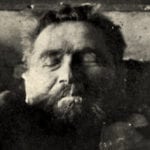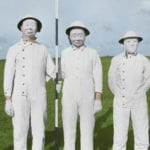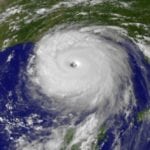 Miscellaneous
Miscellaneous  Miscellaneous
Miscellaneous  History
History 10 Great Escapes That Ended Right Back in Captivity
 Weird Stuff
Weird Stuff 10 Fascinating Things You Might Not Know About Spiders
 Food
Food 10 Everyday Foods You Didn’t Know Were Invented by the U.S. Military
 History
History 10 Odd Things Colonial Americans Kept at Home
 Weird Stuff
Weird Stuff 10 Superstitious Beliefs That Once Consumed Entire Cultures
 History
History 10 Bizarre Friendly Fire Incidents in Military History
 Technology
Technology 10 Modern Technologies That Accidentally Imitate Ancient Magic
 Mysteries
Mysteries 10 Mysteries of the Human Genome
 Weird Stuff
Weird Stuff 10 Things So Rare They’ve Only Been Found Once
 Miscellaneous
Miscellaneous 10 of History’s Most Bell-Ringing Finishing Moves
 History
History 10 Great Escapes That Ended Right Back in Captivity
 Weird Stuff
Weird Stuff 10 Fascinating Things You Might Not Know About Spiders
Who's Behind Listverse?

Jamie Frater
Head Editor
Jamie founded Listverse due to an insatiable desire to share fascinating, obscure, and bizarre facts. He has been a guest speaker on numerous national radio and television stations and is a five time published author.
More About Us Food
Food 10 Everyday Foods You Didn’t Know Were Invented by the U.S. Military
 History
History 10 Odd Things Colonial Americans Kept at Home
 Weird Stuff
Weird Stuff 10 Superstitious Beliefs That Once Consumed Entire Cultures
 History
History 10 Bizarre Friendly Fire Incidents in Military History
 Technology
Technology 10 Modern Technologies That Accidentally Imitate Ancient Magic
 Mysteries
Mysteries 10 Mysteries of the Human Genome
 Weird Stuff
Weird Stuff 10 Things So Rare They’ve Only Been Found Once
10 Forgotten Stories About The Klondike Gold Rush
The Klondike Gold Rush captures the spirit of the Frontier West and the unexplored Canadian wilds. There was a promise that anyone could strike it rich with just a little luck and a lot of determination. However, while everyone had a chance, it was a lot harder than it seemed. Of the 100,000 people who started off on the trip up to the Yukon, only about 30,000 made it there. Not everyone struck it rich from gold, but many made their mark.
10You Couldn’t Pack Light

The Gold Rush began in 1896 with the discovery of gold in Canada’s largely uncharted Yukon territory. Word traveled fast, and within a year the northern reaches of Canada were swamped with people seeking their fortunes.
That caused a serious problem. People needed supplies to survive, and they needed a lot of supplies to survive the rocky, cold, hard trek in the North. Unfortunately, there was a distinct lack of grocery stores along the way. That meant that the small towns along the way were in danger of being overrun and being depleted of food.
The Canadian government enacted a provision that every American crossing the border for gold mining needed to bring their own supplies with them, and they needed to have enough to last them an entire year. That meant that a trip to the Yukon wasn’t just one-way—in some cases, people covered more than 1,610 kilometers (1,000 mi) back and forth between Alaska’s starting point of Dyea to their campsite at Bennett Lake. The two spots were only 53 kilometers (33 mi) apart, but a year’s worth of supplies was heavy and required way more than just one or two trips with a backpack.
The Northern Pacific Railroad put out a brochure with recommended provisions: 181 kilograms (400 lb) of flour, 4.5 kilograms (10 lb) of both coffee and tea, 34 kilograms (75 lb) of dried fruits, 56 kilograms (125 lb) of beans, and non-food supplies like tents, oil blankets, mosquito netting, axes, pitch, a stove, 60 meters (200 ft) of rope, and enough winter clothing to survive months of brutal temperatures.
9Klondike Kate
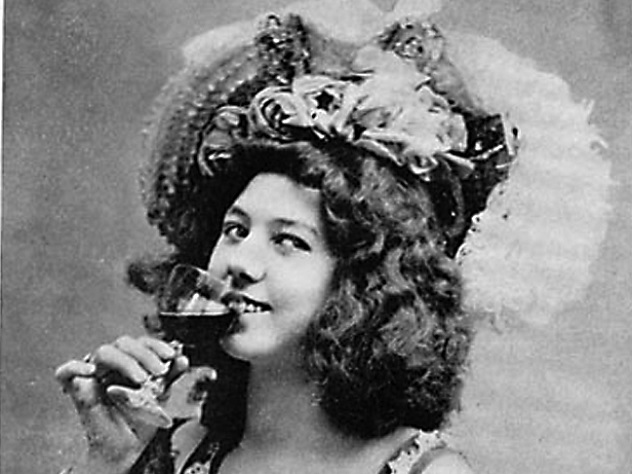
Not all people headed to the Yukon to seek their fortunes were planning on doing any prospecting. Kathleen Rockwell was born somewhere in the Midwest United States, although she was always pretty vague as to where. A dancer by trade, she started out in chorus lines and on the vaudeville stage, but the amount of money that could be made off of miners and prospectors was impossible to pass up.
She found her place in the Savoy in Dawson, Yukon, where she took the stage name “Klondike Kate” and became famous for both her renowned “Flame Dance” and her daring pink tights. She was so popular that she was soon earning gratuities, tips, and a portion of the profits—according to Kate, she made more than $30,000 in her first year onstage. That’s a good amount of money even today—in the 1890s, it would have been simply staggering.
Kate was so popular with the miners, in fact, that they would hand her gold nuggets just for stopping to speak with them on the street. Sadly, her personal life wasn’t as happy, and it took a turn for the worse when she met and fell in love with a man named Alex Pantages. He moved to Seattle with a promise to bring her with him so they could marry—instead, she found out he went on to marry someone else. She ultimately married twice, and she died in 1957 after writing her life story and trying to debunk the idea that she was a gold digger.
8The Second Klondike Kate
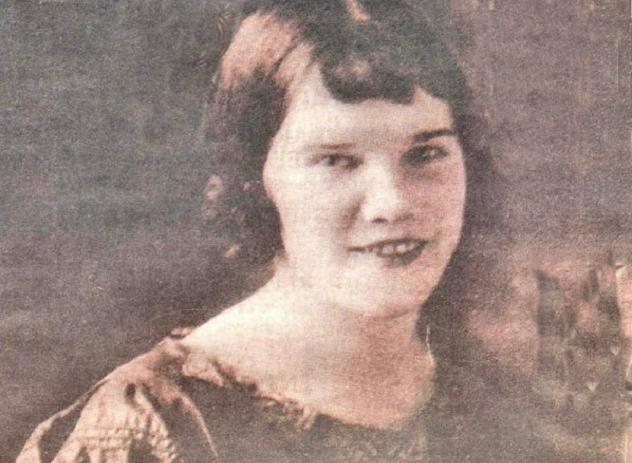
About the same time that Kathleen Rockwell was packing up her skirts to dance, Katherine Ryan was also getting ready to head north. However, she had very different plans for what she was going to do once she got there.
Ryan was working as a nurse in Vancouver when she got word of the Gold Rush fever that was gripping the country. She went north carrying a Winchester rifle and wearing work boots. She was one of the first women to make it up to Alaska and, upon getting there, she teamed up with a detachment of North West Mounted Police officers who helped her carry her year’s worth of supplies in return for some hot meals.
With just $5 to her name, she opened her first restaurant and began investing in some of the gold mines. Within two years, she had not only opened another restaurant—called Klondike Kate’s Cafe—but she had also earned a place within the NWMP as the first female Mountie. As a special constable, she was responsible for dealing with female prisoners and for ensuring that no gold left Canada without the fortunate finders paying all the appropriate taxes.
She helped other miners record their life stories and their adventures, and during World War I she spearheaded fund-raising efforts for the war. She died in 1932, and received a Royal Canadian Mounted Police honor guard for her funeral in recognition of all she had done for her country.
7Dyea: A Klondike Ghost Town
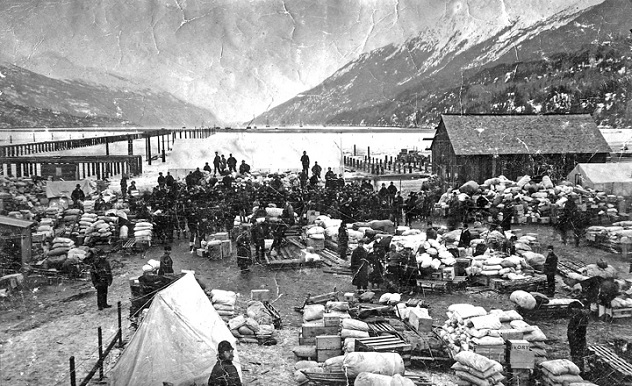
Before the Klondike Gold Rush, Dyea was nothing more than a tiny trading post that sat conveniently on the Taiya River. Native people used it as a point to trade goods coming in from Russia and various United States trading companies, and going out from Canada’s interior.
The river was soon deluged with gold prospectors from the South, and Dyea became the major kickoff point for the Klondike. Between October 1897 and May 1898, the population of the town constantly fluctuated between 5,000 and 8,000 people. In order to deal with this massive influx, the town quickly erected 48 hotels, 47 restaurants, two breweries, four cemeteries, two hospitals, two telephone companies, 39 taverns, and a variety of other services.
The population boom lasted just a few years, though—by 1903, the town had a population of three. Today, Dyea is nothing more than the bare remnants of a ghost town. Many of the buildings have either been demolished or destroyed by the shifting river. Visitors to Dyea can still see some traces of the prosperity that once caused the town’s meteoric rise, including the ruins of a warehouse that stored prospectors’ supplies, a bridge, a rowboat, and the false front of the A.M. Gregg Real Estate Office.
There are also signs that the people who came to Dyea thought they were going to be staying much longer than they did, such as trees carefully planted to form windbreaks that would protect the homes they thought they would permanently live in.
6The Wreck Of The Princess Sophia

By 1918, the Gold Rush had officially fizzled out. As far as gold prospectors were concerned, however, there was still plenty of gold to be found. Rather than stay up in the Yukon year-round, miners would spend their summers looking for gold and their winters in warm southern climates. Ship companies like the Canadian Pacific Railway Company made trip after trip from the the lower provinces and states to Alaska, ferrying miners to their summer searches and winter breaks.
On October 23, 1918, the Princess Sophia left Skagway, Alaska, carrying passengers heading south for the winter. The ship left in spite of warnings of severe weather and drifted off course in the snow, running aground on a reef within hours of leaving port. A number of ships—including a fishing boat and a mail ferry—attempted to help the stranded crew and passengers, but the captain refused all help, not wanting to risk anyone else in getting his own charges disembarked. He was also convinced that the tide would dislodge his ship and, since there didn’t seem to be any damage, he could easily just wait it out.
After two days of waiting, the weather turned even worse, and rescue ships were no longer able to get closer to the beached Princess Sophia. There was one final distress call at 5:20 PM on October 25 before the ship sank. Everyone on board was killed instantly, suffocated by oil that had leaked from the ship and coated the sea. It took 10 years, but the ship’s captain was ultimately cleared of any wrongdoing. Relatives of crew members received a small pension, but no other recompense was ever made.
5The Cremation Of Sam McGee
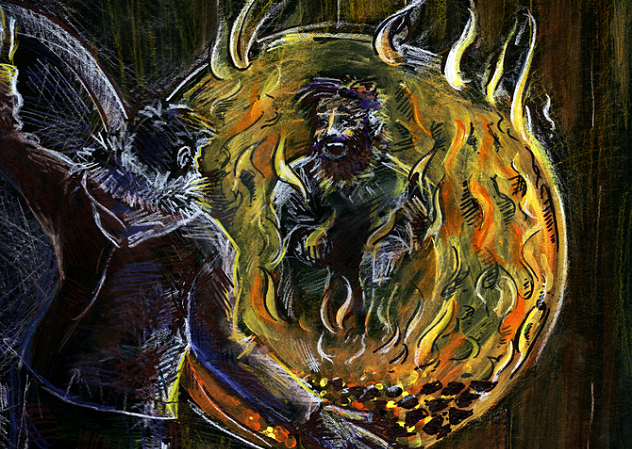
At first glance, poetry doesn’t seem to have a place in the Klondike. But one of its most famous poems—a work by Robert Service—was not only popular back then but has remained so to this day, thanks in large part to a bone-chilling recitation by Johnny Cash.
The poem itself details the hardships faced by prospectors and a man faced with keeping a promise to his dead friend, Sam McGee. Sam’s last wish was to be cremated, so the narrator carries his body to the derelict wreck of a ship and sets it—and Sam—ablaze. In an unexpected twist, McGee is revealed to be alive as the flames simply thawed him out.
There really was a Sam McGee, but he didn’t actually die in the freezing Yukon. Quite the contrary—he lived to the age of 73, when he ultimately died on his daughter’s farm and was buried alongside his wife. McGee was only a part-time prospector who made his money building roads through the Yukon. He moved south with his wife and children in 1909, settling in Montana. He returned to the Yukon twice, upon discovering that people could purchase the supposedly-genuine ashes of one “Sam McGee.”
So how did his name become immortalized in a poem that had little to do with his real life? Robert Service later admitted that he only had a passing knowledge of the real Sam McGee. He actually got the name from a bank ledger and used it because he thought it sounded like an appropriate name for a prospector. There was never any legal dispute about the use of his name, though McGee did decide to change banks as a result.
4“Swiftwater” Bill Gates

The Gold Rush gave birth to its fair share of legends and tall tales. Sometimes, however, the truth is so strange that it runs together with what’s been made up. The story of “Swiftwater” Bill Gates is one such tale. In 1896, Gates was working in Alaska as a dishwasher when he decided to try his hand at prospecting. He sank all of his fortune on a claim with six others—following disappointment after disappointment, they finally hit it rich.
Wealth soon went to his head, and he became well known around Dawson City for his gambling habits and his obsession with a woman named Gussie Lamore. He was so enamored with her that he offered her weight in gold in exchange for her hand in marriage. That is, until he saw her on the arm of someone else. His revenge was bizarre—Gussie loved eggs, which at the time were very hard to find. So he went around and bought them all, an act which earned him the nickname, “The Knight of the Golden Omelet.”
At the end of the Gold Rush he headed to California, still a rich man. There he married Gussie’s sister, Grace, but the marriage ended in complete hatred for each other. His next wife was a 16-year-old named Bera Beebe (whose mother would go on to record his life story). Ditching her—and their son—on the East Coast, he ended up back in Montana. There, he hooked up with yet another one of Gussie’s sisters, Belle, and then married his own 14-year-old niece shortly thereafter.
He ended up getting arrested for kidnapping said niece, though the charges didn’t stick. Once again a free man, he divorced Bera, who committed suicide after declaring her undying love for him. In response, he married yet another woman, this one named Kitty. That marriage didn’t last either, and two years later he wed an 18-year-old girl named Sadie.
According to the story, when the government finally caught up to him in regards to unpaid child support, Gates absconded to Peru, where he was ultimately murdered in 1937. Reportedly, he was still searching for more gold.
3Wyatt Earp In The Klondike
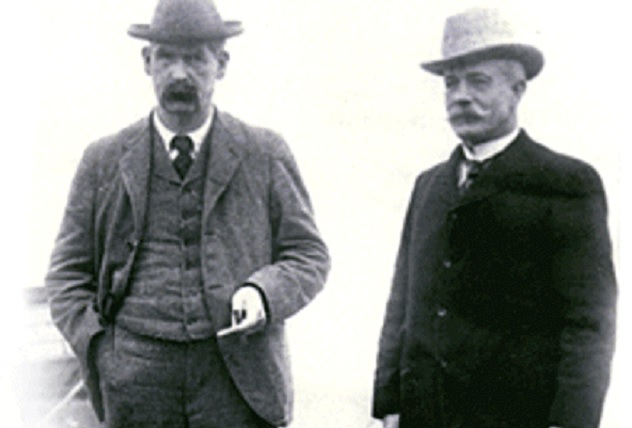
After the famous events of Tombstone, Arizona, Wyatt Earp and his wife disappeared into the Yukon. Not a lot of news regarding Earp’s stay while up there filtered down into the United States. According to town records in Wrangell, Alaska, he acted as a a deputy marshal for 10 days, although nothing of note happened.
According to the New York Sun, though, Earp met his match in a rather polite RCMP officer. When Earp made his way into Dawson City, the story claimed, he traded his street clothes for his guns and went about cleaning up the place the only way he knew how—by shooting up the town. The Mounties that were charged with keeping the peace weren’t interested in any of that nonsense, and one—specifically said to be only about 150 centimeters (5 ft) tall—approached the gunfighter and demanded Earp surrender his gun.
There was much swearing and cursing and refusal on Earp’s part, but the unnamed Mountie (referred by the Sun as “the little chap”) wasn’t impressed. His polite-yet-firm request never wavered, and although Earp was said to want to kill the man for his audacity, he was talked out of it when friends pointed out that killing a Mountie would invoke the wrath of the entire British Empire. Earp put his guns away and put back on his street clothes.
It’s a great story, and one can see why a United States newspaper would want to run such a damning piece on Earp. However, when the Dawson Record ran the story, they added an introductory paragraph stating how nobody in town remembered any such incident actually happening.
2The Buffalo Soldiers

The Gold Rush occurred shortly after the Civil War, so it was still a time when military units were strictly racially segregated. The RCMP was scrambling to maintain order, secure the border between Canada and the United States, and ensure that those who were coming into the country were bringing their own supplies with them—to put it mildly, they were overwhelmed.
So the United States military sent in the Buffalo Soldiers. Company L of the 24th Infantry Regiment was comprised mostly of soldiers hailing from the Deep South trying to make better lives for themselves and their familes while living among overt racism. The Buffalo Soldiers received their name from another US minority—Native Americans, whose tribes likened the Regiment’s fighting prowess, skill, and bravery to that of the buffalo.
The unit was tasked with cleaning up Skagway, Alaska—a Gold Rush boomtown that had become “little better than Hell on Earth.” Arriving there in 1899, the Buffalo Soldiers found con men preying on prospectors and violence in the streets. Not only did the soldiers drive out the criminals—while facing much of the same racial prejudice that they experienced in the US—but they also paved the way toward preserving what would eventually become a piece of history. At the same time Company L was saving Skagway and making sure its citizens and prospectors didn’t go hungry, they were also building the first museum within a national park.
1Soapy Smith
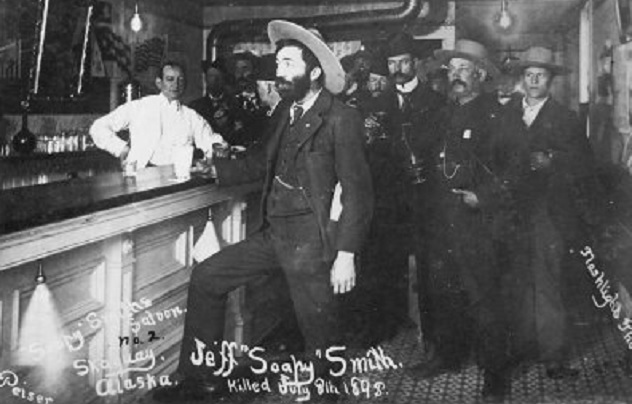
Jefferson “Soapy” Randolph Smith was already a famous con man before he headed up to the Klondike to see what fortunes awaited him there. Called the “King of the Frontier Con Men,” it wasn’t long after his arrival in Skagway that he had his fingers in every illegal activity in town.
In May 1898, he opened his own establishment from which he ran his gang of con men, thieves, and cutthroats. The bar even contained secret exits that would allow these shady characters to quietly escape with their clients’ money.
One of his less violent cons was the establishment of a telegraph office—a reassuring sight for newcomers who wanted to let those back home know that they’d arrived safely. For $5, the operation would send a telegram for you—the only problem was, there were no telegraph wires in the town. Once lured into the office to supposedly send their message, the mark would witness an ongoing card game where one player was suddenly called away. The friendly card players would offer the newcomer his seat and proceed to take him for everything he had.
Soapy Smith’s reign of terror continued without incident largely because he had bought the United States Marshall’s cooperation. He also had his own personal guard in the guise of a military unit. This led to the assignment of the Buffalo Soldiers to clean up the crooked town.
After the USS Maine was sunk off the coast of Cuba, Smith rode the wave of sudden patriotism. He even petitioned the War Department for permission to form his own official division of the US Military—and he received it. It allowed him to not only assemble his own troops, but to legally use them—in any way he saw fit—to maintain his control over the town. Ultimately, though, this was the last straw, and vigilante townspeople rose up and murdered Smith in July 1898.

